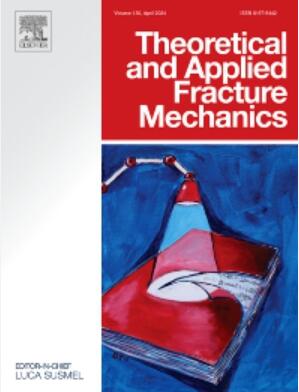Investigating the interaction mechanisms between fissures and layers of SCB specimens using a novel layer 3D printing technology and DEM
IF 5.6
2区 工程技术
Q1 ENGINEERING, MECHANICAL
引用次数: 0
Abstract
Layered rock masses are widely distributed, and their unique structures affect engineering stability. Hence, it is important to conduct research on layered rock fracture mechanisms. This study aims to explore the interaction mechanisms between bedding and fissures. A layered rock sand 3D printing molding process is proposed to prepare Semi-Circular Bending (SCB) specimens containing bedding and pre-fabricated fissures. Crack propagation tests under three-point bending loads are carried out, and the strain distribution is obtained by combining with DIC technique. The PFC2D software is used for numerical simulation. Results show that the bedding inclination angle β and pre-fabricated fissure inclination angle α significantly influence the mechanical behavior and peak strength of SCB specimens: variations in β (0° − 90°) result in differing complexities of crack propagation paths (e.g., the most tortuous path at β = 30°), with peak strength first increasing then decreasing (maximum at β = 30°), while changes in α (15° − 75°) cause peak strength to first decrease then increase (minimum at α = 30° and 45°), collectively revealing the relationship between bedding-aligned crack extension mechanisms and strength evolution. The location of tensile stress concentration guide the crack propagation. The angle and relative position between the fissure and the bedding are the key factors determining the crack propagation path and the specimen failure mode. The preparation method of the bedding rock mass structure by sand 3D printing proposed can effectively simulate the characteristics of natural bedding planes, providing a new approach for the study of the fracture mechanics of layered rock masses. By combining experiments and numerical simulations, the interaction mechanism between bedding planes and fissures is deeply analyzed, and the research results have important reference value for the stability analysis and design of rock engineering.
利用一种新型的层3D打印技术和DEM研究SCB试样的裂缝和层之间的相互作用机制
层状岩体分布广泛,其独特的结构影响着工程的稳定性。因此,开展层状岩石断裂机理研究具有重要意义。本研究旨在探讨层理与裂缝的相互作用机制。提出了一种层状岩砂3D打印成型工艺,制备含层理和预制裂缝的半圆弯曲(SCB)试件。进行了三点弯曲载荷下的裂纹扩展试验,结合DIC技术得到了裂纹的应变分布。采用PFC2D软件进行数值模拟。结果表明:层理倾角β和预制裂隙倾角α对SCB试样的力学行为和峰值强度有显著影响;β(0°~ 90°)的变化导致裂纹扩展路径的复杂性不同(例如,在β = 30°时路径最曲折),峰值强度先增大后减小(在β = 30°时最大值),而α(15°~ 75°)的变化导致峰值强度先减小后增大(在α = 30°和45°时最小),共同揭示了顺层裂纹扩展机制与强度演化之间的关系。拉应力集中的位置引导裂纹扩展。裂纹与层理之间的角度和相对位置是决定裂纹扩展路径和试样破坏模式的关键因素。提出的砂体3D打印制备顺层岩体结构的方法能够有效模拟天然顺层面的特征,为研究层状岩体的断裂力学提供了新的途径。通过实验与数值模拟相结合的方法,深入分析了顺层面与裂隙的相互作用机理,研究成果对岩石工程的稳定性分析与设计具有重要的参考价值。
本文章由计算机程序翻译,如有差异,请以英文原文为准。
求助全文
约1分钟内获得全文
求助全文
来源期刊

Theoretical and Applied Fracture Mechanics
工程技术-工程:机械
CiteScore
8.40
自引率
18.90%
发文量
435
审稿时长
37 days
期刊介绍:
Theoretical and Applied Fracture Mechanics'' aims & scopes have been re-designed to cover both the theoretical, applied, and numerical aspects associated with those cracking related phenomena taking place, at a micro-, meso-, and macroscopic level, in materials/components/structures of any kind.
The journal aims to cover the cracking/mechanical behaviour of materials/components/structures in those situations involving both time-independent and time-dependent system of external forces/moments (such as, for instance, quasi-static, impulsive, impact, blasting, creep, contact, and fatigue loading). Since, under the above circumstances, the mechanical behaviour of cracked materials/components/structures is also affected by the environmental conditions, the journal would consider also those theoretical/experimental research works investigating the effect of external variables such as, for instance, the effect of corrosive environments as well as of high/low-temperature.
 求助内容:
求助内容: 应助结果提醒方式:
应助结果提醒方式:


